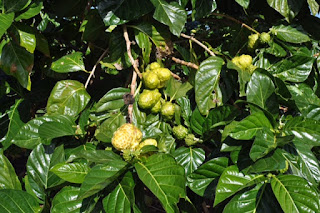There are a lot of amazing vegan cheese alternatives: cashew cheese, nutritional yeast, and many others. But blue cheese has a flavor that’s pretty hard to imitate. Until now!
Noni is often known as “cheesy fruit,” because the raw fruit has a flavor and smell that’s strikingly similar to blue cheese. The problem is, because the fruit has no shelf life, it’s very difficult to get access to the fresh fruit to use as a blue cheese substitute.
Lucky for you, we at Hawaiian Organic Noni have developed a way to stop the fresh fruit from fermenting: our low-heat dehydration process. The result is a noni fruit leather with that tangy, blue cheesy taste, all ready to be put to use in dips, dressings, and salads.
Noni fruit is more than just a great substitute for blue cheese. It’s one of the most powerful foods for healing in the world, containing 165 beneficial compounds that repair and maintain the human body. It has more antioxidants than apples, pomegranate, and acai, and it’s been shown to slow aging, prevent disease, and even balance out the body’s blood sugar levels.
Here are three simple recipes that use Hawaiian Organic Noni fruit leather as a blue cheese substitute:
Noni “Blue Cheese” Vinaigrette
This delicious salad dressing isn’t anything like the chunky, creamy blue cheese dressing you might be familiar with. Instead, it’s a light vinaigrette, packed full of blue cheese flavor from noni fruit infused in the olive oil.
Serve over your favorite mixed salad. It pairs great with salads that contain some fruit, like apples or pineapple chunks, and nuts.
Makes enough to dress a main course salad for four, depending on how much dressing you like on your salads. You can adjust the amount of noni you use for a stronger or milder flavor.
Ingredients:
- ¾ cup extra-virgin olive oil
- ¼ cup lemon juice
- ¼ tsp salt
- ¼ tsp pepper
- Cut the noni up into small pieces, and dissolve in olive oil.
- While it’s dissolving, mix the rest of the ingredients together.
- Add the noni and olive oil to the rest of the ingredients.
- Whisk until the salad dressing emulsifies to a smooth, slightly thickened texture.
- Use to dress your favorite salad.
Noni “Blue Cheese” Salad
Blue cheese crumbles are a common ingredient in many salads, and now there’s a great vegan substitute. Use pieces of noni fruit leather in the place of blue cheese, and you’ll get that delicious, tangy flavor—totally vegan! Plus you get all the amazing benefits of noni fruit.
Feel free to mix up the other salad ingredients as you prefer.
Makes enough for 4 large main course salads. You can adjust the amount of noni you use for more or less blue cheese flavor.
Ingredients:
- 4 cups fresh organic spinach
- 4 cups organic leaf lettuce
- 2 organic apples, chopped into 1 inch cubes
- ¾ cup grape tomatoes, halved
- 1 small red onion, very thinly sliced
- 1 cup coarsely chopped pecans
- 1 recipe lemon thyme vinaigrette (recipe follows)
- Freshly ground black pepper
- Distribute spinach and lettuce among four salad bowls.
- Lightly drizzle each salad with dressing, and top with a little black pepper.
Lemon Thyme Vinaigrette
This delicious, simple dressing is great on just about any kind of salad.
Ingredients:
- 4 Tbsp fresh lemon juice
- 1 Tbsp Dijon mustard
- 2 tsp chopped fresh thyme
- ½ cup olive oil
- Mix first three ingredients until well combined.
- Drizzle in olive oil as you whisk.
- Whisk until dressing thickens slightly and becomes smooth.
Click here for the full version and access to a recipe for Noni “Blue Cheese” Dip
Noni Puree
This recipe makes way more than you need for the dip, so you can use the leftovers to make Noni Tea. The puree will keep for a few days in the fridge.
Makes 2+ cups.
- To a blender, add:
- 2 cups water
- Spin in blender until smooth and consistency of applesauce


